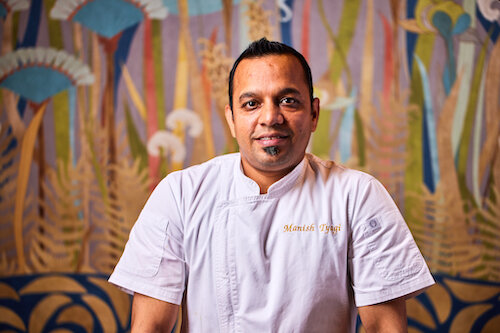Aurum’s Wildly Creative Menu is Cheese Evolution at its Finest
Aurum chef Manish Tyagi
When chef Manish Tyagi opened Aurum — a contemporary upscale Indian restaurant in Los Altos, California—cheese lovers took note of the many dairy-heavy dishes on the menu. In addition to using traditional Indian paneer, Tyagi is also cooking with tangy goat cheese, sharp cheddar, creamy mozzarella, and flavorful blue cheese.
This kind of fusion is not surprising from a chef who beat Bobby Flay on “Eye of the Tiger” by making a lasagna-inspired interpretation of palak paneer with a cheddar crust. Tyagi (formerly of San Francisco favorites August 1 Five and Amber Dhara) learned his craft in high-end hotel restaurants in India, where he mastered local and Western cooking styles. Since moving to the U.S. decades ago, he has become known for fusion takes on Indian classics, like the Kashmiri chili wings he made at August 1 Five, which closed a few months into the pandemic.
At Aurum, Tyagi continues to experiment with using Western ingredients in Indian dishes, but he doesn’t call his style fusion. Instead, he sees his embrace of non-traditional ingredients as an extension of the way Indian food has evolved over the centuries to embrace ingredients like tomatoes, spices, and chiles, which weren’t part of the cuisine until the arrival of the Portuguese.
I spoke to Tyagi about how he came to like cheese and how he developed the curd-forward dishes on his menu:
When did you first develop your interest in cooking with cheeses?
Manish Tyagi (MT): My dad is a very fun-loving, foodie person. At home, food was always a prime kind of discussion, and dad used to call his friends to enjoy my mom's cooking. I was her helper, and I used to take care of the legumes and all these small things, even rolling the chapatis. I used to ask a lot of questions: Why do you use this spice particularly at this point in time, why not later? What are the differences between browning the onions or just sautéing the onions? So all this curiosity started from there.
When I growing up, there was only one cheese, which is very common in Indian households: paneer. But there are different ways we used curdled milk: When you put it in a cheesecloth and tie it up, you get paneer, but if you don't tie it up—you just strain it through cheesecloth—you get ricotta. And when you do a culture for making a different base, then you'll get other different cheeses. Depending on the amount of time you leave them, you can get a really good sharpness in them. So I had seen my family using these methods.
When did you first start working with European and Western cheeses?
MT: Around the year 2000, I was taking entrance examinations for various scholarships, and I got into culinary school. In my final year, I was selected to work in the kitchen of Oberoi hotels, which is one of the premier hotel chains in India, and we started learning about cheeses. We started with France and Italy, and then other places, like Holland and Germany. I got so much into learning and enjoying this topic. So that’s how this interest started building up.
The Oberoi has a very famous Italian restaurant, Travertino, and I got a chance to intern there for some time and learned a lot of techniques. This actually gave me a sense of how you can use the same ingredients, but, as you change the cuisine, perspectives change, flavors change, appearances can change. So his helped me a lot in understanding and build up my own style.
Can you tell us a little more about the cheese-focused dishes on your new menu? When you cook with Western cheeses, how do you choose which ones to use?
MT: My idea is always to balance the sharpness and the richness in a dish, and then play around with the flavors and see where cheese fits into that.
Paneer Hori
Paneer Kebab
The Old Town Delhi paneer kebab is a very traditional Punjabi style of cooking, tandoori cooking. I’m just adding my touch and the way I like to eat it. It's been marinated with yogurt, mustard oil, and spices, and we make our own spice blend here— I don't use the market blend garam masala—so that gives it a very different taste. And because we are not able to use a coal fire here, I use liquid smoke.
RaGa Kofta
The RaGa koftas are a kind of vegetarian meatball. In Indian cuisine, malai kofta is a popular type of kofta made with grated paneer and served in a sauce made with cream. I wanted to make something along those lines, so I opted to use mozzarella.
Cheese toast
Cheese Toast
For the Double Trouble: The British ruled India for 200 years, and this is from that Anglo-Indian cuisine. Eating cheese this way was introduced to India by British soldiers, and cheese-chile toast used to be served in their quarters and all. I added freshness to it by adding a blue cheese. It used to be just mozzarella or cheddar, melted. Traditionally Indians don't like blue cheese, but I kind of developed the taste for it, so I decided to add it. It’s kind of a crumble on top, so if somebody don't want it, they can dust it off and have just the mozzarella and cheddar cheeses.
Kulcha
Kulcha
And the kulcha: Traditionally, in India, we have a paneer kulcha—just paneer mixed with spices and herbs. I took out the paneer and used goat cheese. Obviously goat cheese has a very different texture from traditional paneer. Goat cheese has more intensity and a more complex flavor profile. I like the tartness in that and the cheesiness, the creaminess.




